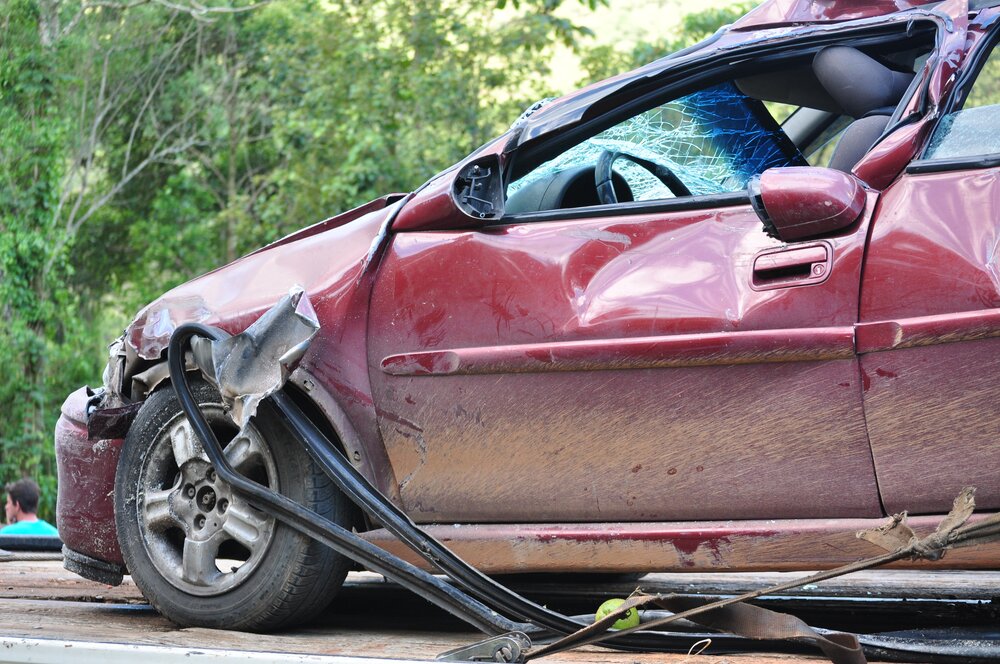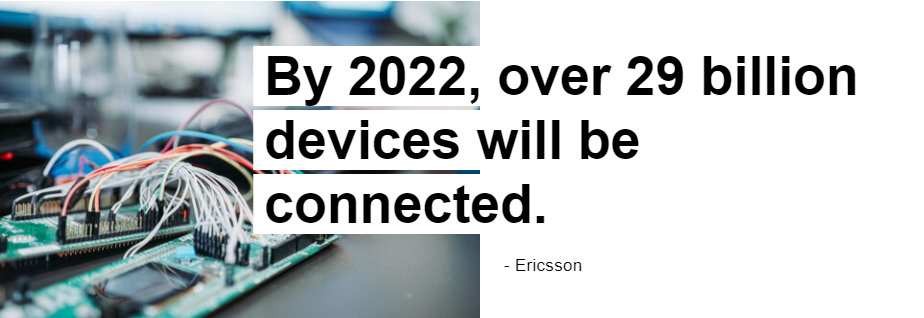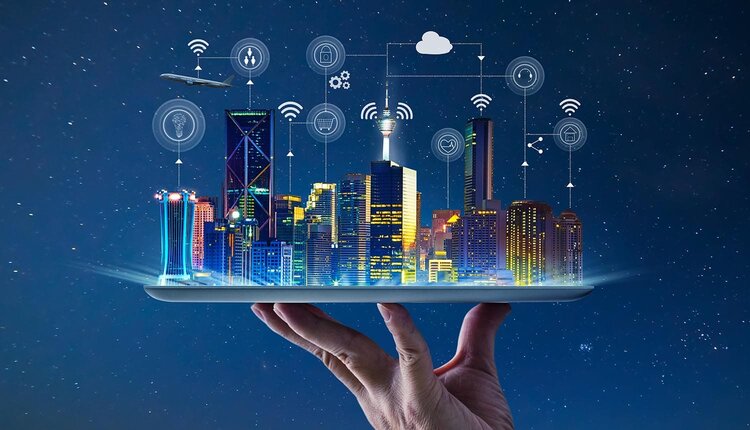FINDING PRACTICAL SOLUTIONS WITH THE INTERNET OF THINGS
A high-pitched drone echoed in her ears.
Angela blinked, her brain struggling to process the smells and sights around her. Deflated airbag. A spiderweb of glass. An acrid stench assaulted her nose along with the unmistakable smell of burnt rubber. Angela gingerly lifted her hand to her forehead, investigating the throbbing warmth she felt there. As her senses began to catch up, she lowered her hand to see fingertips stained with crimson.
I think I’m okay, she thought to herself. “I’m okay,” she said aloud to no one, trying to convince herself it was true. A quick glance out the passenger side door told her all she needed to know. The crumpled front end of a truck that mere moments before had sailed through a red light was entangled with hers. Her anger bubbled. Her light had been green, she was certain. Her car door creaked open as helping hands guided her away to safety.

Side-impact collisions are a sad reality of many well-traveled intersections—often the result of a careless driver. These accidents are among the deadliest. Drivers that can walk away from such accidents are considered lucky, then left with potentially significant injuries and large medical and repair bills. How could technology be a potential solution to these accidents so ones like Angela’s could be avoided?
Today’s technological landscape is a brave new world, full of unfamiliar concepts with inscrutable names: artificial intelligence, blockchain, data mining, machine learning, quantum computing, and the Internet of Things (IoT).
The hype around these new technologies can make it harder to understand their real benefits. Technology has a lot of complexities, and many of them are glossed over by a haze of hype.
Here, we’re going to focus on the basics of a possible solution to everyday problems that can save time, money, and—potentially—lives.
You’re sure to have heard of the concept of the Internet of Things by now. Maybe you understand all the complexities, maybe not, or maybe you just pretend you do. In this post, we peek into the intricacies of IoT.
The Internet of Things
The Internet of Things, in short, is connecting the unconnected.
IoT refers to connecting devices to the Internet and often each other in order to increase functionality or productivity. Sometimes, it might be used for security or safety.
In this age of IoT, your lightbulbs, your fridge, your washing machine, and even your car might all be connected to the Internet, collecting and sharing data. Almost any device that’s capable of being turned off and on can be connected through IoT.
Just a few years ago, analyst firm Gartner expected that, by 2020, over 20 billion devices would be connected. However, according to Stastica, that number was surpassed already in early 2018. Telecommunications giant Ericsson anticipates 29 billion connected devices by 2022. Around 50% of that number will not be our familiar and expected Internet-enabled smartphones, but rather wide-area and short-range IoT devices. That kind of growth is explosive and potentially life-altering. What can these numbers do for you?

It’s probably safe to assume that, as we advance further in to the future, anything capable of being connected probably will. I even shared a story in my book, Get in the Boat: A Journey to Relevance, explaining how some enterprising dairy farmers have capitalized on IoT and food trends.
Consider the cost of a gallon of milk. Organic milk costs a few dollars more than conventional milk. As the competition in organic farming grows, some farms in Ireland are making a push to offer a benefit to the consumer and give themselves a selling edge. In a large production farm, cows are milked by machine. If each cow is outfitted with a sensor that is scanned when she is milked, the resulting milk can be identified as hers. In these locations, conscientious consumers could actually select and receive milk from a specific cow with this application of IoT, giving them the experience of purchasing from a small dairy as the company continues to grow. It’s quite an innovative way to connect the unconnected, huh? Although this is just one example, the far-reaching possibilities of IoT are limitless in their ability to help us understand and improve our work and the way we live.
IoT for Transportation
A particularly beneficial advancement of IoT is occurring in transportation. New systems are continually being set up, changing the way we travel by air and rail. The London Underground has embraced IoT for both speed of travel and information on the potential need for repairs, from elevators to HVAC systems. This wealth of information saves time and money.
But how can IoT help those of who regularly commute by car? While exciting IoT possibilities are ahead in the future for all autonomous vehicles, let’s focus on how we can improve local transportation today by using IoT with human and computer intelligence.

Medi Jaafari, Systems Engineer from Cisco Systems, has focused on bringing technological solutions to state and local governments throughout his career. In a recent conversation, Jaafari shared many benefits in his experience of helping governments move toward smart cities, including reduced energy bills, efficient budgets that attract new businesses, and marketplace leadership. These smart cities offer more than just information from sensors. They can use that data to offer solutions for traffic to increase safety and security, improve lighting and power efficiency, and provide the ability to more quickly and easily find parking. They can also implement innovative solutions for waste management.
IoT systems implemented in cities can help to track the number of vehicles on given roadways and traffic trends to help governments understand roadway and infrastructure usage. This information can give local governments real data to make decisions about maintenance and future growth expectations, helping them to use budgets wisely.
By using IoT enabled major roadways in a city, it’s possible to implement digital red-light systems. These systems allow the ability to dynamically change red-light timing, addressing congestion in real time.
Attempting to unclog major arteries of a city by widening the roads is expensive, labor intensive, and full of delays and red tape. Sometimes, widening roads isn’t an option when there’s no room left to widen. The best of transportation advances should include physical redesign and digital optimization to protect infrastructure investments using IoT. These applications can bring traffic solutions into the 21stcentury.
Rather than lights just being set on a timer or outdated magnetic strips that only sense the presence of a single car, digital intersections can count actual cars. The ability to understand that level of congestion enables those intersections to be dynamically controlled. This control translates into tailored timing for each intersection, which results in better dissipation of congestion.
Pairing IoT with city infrastructure can provide services that are vital to safety, including emergency services and evacuations. At digital intersections, longer green lights give quicker egress for the means of evacuation. Those same intersections allow for dynamic response to the path of emergency vehicles, reducing response time that can be the difference between life and death.

What about poor Angela at the beginning of this post? A digital intersection could probably have prevented her accident. The technology is present for high-definition cameras that use machine learning to anticipate a careless driver’s attempt to beat a red light. A digital intersection that can sense a potential collision could have held Angela’s red light a little bit longer to avoid a catastrophe. Think of the implications: an increase in commuter safety, reduction of insurance and health premiums, less strain on emergency services, and additional reduction in travel time thanks to fewer accidents.
Despite the myriad benefits of moving toward this ideal, some cities are reluctant to invest in these solutions. They might lack citizen action demanding this type of technology or citizen support to help them understand the benefits of this technology. Without conviction or support from the people to invest in our cities in this way, it’s easy for government to fail to dedicate funds to the advancement of our cities’ efficiency, safety, and security.
Growing the application of IoT
IoT and its applications can only grow from here as it becomes prevalent and permanent. While you might not be in the business of helping people like Angela avoid car accidents, you have an opportunity to put IoT to work for your business. Connecting the unconnected drives new business models and personalizes customer experiences. It’s a smart way to add value to your workflow—increasing speed, reducing costs and waste, and delighting your customers.
A common barrier to implementing smart IoT usage in business is overlooking the opportunities where IoT will add value. What opportunities for IoT are waiting for you, your business, and your customers?
At ROVE, we work with you to analyze the needs of your business, including the needs of your employees and customers, to find a solution that fits your particular situation. Like many solutions in technology, including IoT, there is no one-size-fits-all answer to your needs. Through our consulting-led approach, ROVE helps your organization navigate the complexity of modern security and supports the success of your organization’s digital transformation while minimizing risk. A Veteran-owned business, ROVE demonstrates proficiency and experience across many industries and business sizes. You can expect innovation and confidence in the path we find together connecting you to digital success.
Written by:
Pat Bodin, Chief Technical Officer, ROVE
With:
Medi Jaafari, Technical Solutions Architect, Cisco